Course Website for
Principles of Operating Systems (26605)
Spring 2024
Site last revised 10:15 PM ET 6-May-2024
Dr. James L. Frankel
Final Project Presentation Slots:
| Time |
Slot |
Available |
| 6:45 PM - 7:00 PM |
Slot 1 |
Filled by Keenan |
| 7:00 PM - 7:15 PM |
Slot 2 |
Filled by Pierre-David |
| 7:15 PM - 7:30 PM |
Slot 3 |
Filled by Nathan |
| 7:30 PM - 7:45 PM |
Slot 4 |
Filled by Lucas |
| 7:45 PM - 8:00 PM |
Slot 5 |
Filled by Justin |
| 8:00 PM - 8:15 PM |
Slot 6 |
Filled by Alejandro |
| 8:15 PM - 8:30 PM |
Slot 7 |
Filled by Julian |
| 8:30 PM - 8:45 PM |
Slot 8 |
Filled by Aliya |
| 8:45 PM - 9:00 PM |
Slot 9 |
Filled by Adi |
| 9:00 PM - 9:15 PM |
Slot 10 |
Filled by Leonid |
After the current Spring 2024 semester, the
next time CSCI E-92 will be offered is in the Fall 2025
semester.
We will be holding our first section meeting
on Tuesday, January 23, 2024 at 6:45 PM ET. Note that this section
meeting is *before* our first class meeting.
Both section and class meetings are live streamed and are also
available after class for later viewing and reviewing.
Many links in the course website are not yet
available. They will be activated as the course
progresses.
Quick Links:
Class Hours and Location:
Tuesdays 8:00-10:15 PM in 53 Church Street, Room L01. Students can attend in person on campus, participate live online at the time the class meets via web conference, or watch the recorded video on demand. Recorded sessions are typically available within a few hours of the end of class and no later than the following business day. Students who attend this course in person must comply with the Harvard Extension School mandatory COVID-19 immunization documentation policy. See Immunization Requirements.
Distance Learning Links including Video Streaming, Chat, and the Midterm Exam:
During Class:
Video Streaming:
In addition to being able to participate in section & class in person, both are live streamed and also recorded. Students are encouraged to share their video feed and to ask questions verbally using their audio/video link in Zoom. The section & class live video stream is available through the class Canvas web site under Zoom.
Chat:
Questions can also be asked using the text Chat facility in Zoom during class meetings & during section meetings. Please use the chat feature available in Zoom rather than Canvas chat. We will *not* be monitoring Canvas chat.
After Class:
Videos of class and section are available on the course's Canvas web site under Class Recordings.
Midterm Exam
Our midterm exam is a three hour long proctored exam that
will be available on-line
through Canvas with
integrity protected by Proctorio.
Students must start the exam within the 24-hour period that begins at
the designated start time of our midterm exam and ends 24 hours later.
Students will have three hours to complete the exam independent of
when they start. More information will be available about the exam
later in the semester.
The exam does not allow access to any books or
notes, but relevant course slides will be made available. No
electronic devices are allowed.
Prerequisites:
Knowledge of data structures and programming experience, such as is
taught
in CSCI
E-22 (formerly CSCI E-119) (Data Structures), is required.
Experience using UNIX/Linux or equivalent at the shell level and the
system programming level is strongly recommended, but not required.
Students must have sufficient experience to write programming projects
of modest size and complexity in the C Programming Language that
utilize a variety of data structures. This course does *not*
teach programming.
Brief abstract:
This course examines the role of operating systems: process
synchronization and scheduling; memory management including virtual
memory, swapping, paging, and segmentation; file management;
protection and security; input/output techniques, buffering, and
resource allocation; deadlock detection and avoidance; system
modeling; performance measurement and evaluation; and operating system
case studies. An extensive lab project will be required of all
students.
4 credits. Graduate credit.
Learning Objectives:
Students will come away with both a theoretical and practical
understanding of the workings of operating systems. The material forms
a strong underpinning for all programmers and results in methodologies
for effective use of concurrency/parallelism, I/O and file systems,
security, virtual memory, and virtual machines. In this course, we
will study processes, threads, and schedulers, address spaces, virtual
memory, memory protection, file systems, security and protection. In
addition to writing an operating system, material covered in this
class includes information about utilizing an ARM processor at the
lowest level, the ARM instruction set, navigating through hardware
schematics, interfacing to a variety of I/O devices, designing a
device-independent interface to I/O systems, and creating a
multiprocessing scheduler. The knowledge and skills learned in this
course will benefit every student throughout their future careers.
Overview:
Computer Science E-92 is a detailed exploration of the internal
algorithms and design of operating systems. Students are expected to
be comfortable with designing, coding, and debugging programs of
reasonable complexity while employing good programming style and
structured techniques. In particular, knowledge of C, terminal and
text file I/O, iterative and conditional control structures, parameter
passing and recursion, and data structures is presumed. During this
class, students will use some UNIX system calls to complete the
assignments.
A significant portion of the class will involve the design and
implementation of a major term project. The project will be developed
by each student working alone. That project is the core of a new
operating system implemented from scratch for an ARM processor.
Initially, both the classroom lectures and the section meetings will
be covering material important to the design and implementation of the
final project. Later in the semester, advanced topics will be covered
in class; however, both the class and sections will continue to
support students as term projects progress. For the term project,
students will continue working on and debugging their projects leading
to their complete implementation and a final demonstration.
Because the course includes a required
and significant term project involving both
programming and hardware implementation, the assignments will be
time-consuming; therefore, a significant time commitment to the course
is necessary. Although the relevant experience of students in the
class is usually quite diverse, depending on background, it is not
unusual for students to spend 10-15 hours per week or more completing
the readings and homework assignments. Although the computers are
available more-or-less around the clock, occasionally they will
suddenly become unavailable (this is known as a crash). As
with all such events, they always seem to occur at the worst possible
time. Plan your computer work so that it is complete in advance of
the deadlines. Check in your code to the required class git
repository frequently. You have now been
forewarned!
Books/Course Bibliography:
All course books are available from the Harvard Coop and are available for on-line ordering. A link to course materials at the Coop is available for on-line purchasing. Keep in mind that Coop members receive a 10% discount. There are links available on Canvas to find the Library Reserves and, for some books, these include ONLINE ACCESS versions. In addition, all registered students will be eligible for library services (access, borrowing privileges, group study rooms) in FAS libraries, just like any other student in FAS. The Harvard Library website includes information about how to access library materials both in person and remotely. All registered students will continue to have access to Harvard Library on-line resources.
Textbook:
Modern Operating Systems, Fifth Edition; Andrew S. Tanenbaum and Herbert Bos; Prentice-Hall, 2023, 2014, 2008; ISBN-13 978-0-13-761887-3
Or, if the updated and preferred Fifth Edition is not accessible:
Modern Operating Systems, Fourth Edition; Andrew S. Tanenbaum and Herbert Bos; Prentice-Hall, 2015, 2008; ISBN-13 978-0-13-359162-0
Optional UNIX and POSIX Library Function Reference Books:
Advanced Programming in the UNIX Environment, Third Edition; W. Richard Stevens and Stephen A. Rago; Addison Wesley Professional, 2013; ISBN-13 978-0-32-163773-4
PThreads Programming: A POSIX Standard for Better Multiprocessing; Bradford Nichols, Dick Buttlar, Jacqueline Proulx Farrell; O'Reilly & Associates, Inc., 1996; ISBN-10 1-56592-115-1; ISBN-13 978-1-56592-115-3
Recommended C Language Reference Manual:
C: A Reference Manual, Fifth Edition; Samuel P. Harbison and Guy L. Steele, Jr.; Prentice Hall, 2002; ISBN-13 978-0-13-089592-9; Errata for the Third Edition from Sam Harbison; Our additional errata
Optional git Books:
Dangit, Git!: Recipes for Gitting out of a Git Mess; Katie Sylor-Miller and Julia Evans; This short on-line book describes git fundamentals.
Pro Git, 2nd Edition; Scott Chacon and Ben Straub; Apress, 2014; ISBN-13 978-1-4842-0077-3. This is a comprehensive book about git. It is also available for free download at the web site above.
There will also be other handouts & supplementary
readings
Instructor:
Dr. James L. Frankel 
- President, Frankel and Associates, Incorporated
- Brief Bio:
- Prof. Frankel's background includes work in start-ups, academia, and research.
- He has worked at IBM Research Yorktown Heights, Xerox PARC, Digital Equipment Corporation, Thinking Machines, and Mitsubishi Electric Research Labs.
- In addition to Frankel and Associates, he has built CommerceTone, Auripay, Incentive Targeting, and has worked with numerous consulting clients.
- He was the 2019 recipient of the Petra Shattuck Excellence in Teaching Award.
- Office hours:
- Via phone and/or web conference
- By appointment
- E-mail address:
 . Questions whose answers would be relevant to the whole class should be posed via Ed Discussion. For some appropriate issues (grading questions, personal issues, etc.), e-mail should be sent to the professor and also to both TAs.
. Questions whose answers would be relevant to the whole class should be posed via Ed Discussion. For some appropriate issues (grading questions, personal issues, etc.), e-mail should be sent to the professor and also to both TAs.
- Phone: +1.617.401.7480
Teaching Assistants:
We have two Teaching Assistants (TAs) for this course. The TAs
hold a weekly section meeting and office hours as described below.
The information delivered during the TAs' section meeting is a
required component of the course. Course material will be covered in
section -- either in toto or in more detail -- that time does
not permit to be covered in class meetings. For example, this
material includes use of git and GitHub; general approaches to solving
the problem sets; overviews of algorithms, code snippets, and data
structures. Also, the section meetings provide a venue in which it
may be easier to ask more lengthy questions. When appropriate to send
e-mail, please send e-mail to both TAs and to the course
instructor.
| TA |
Section Meeting Time/Place |
Office Hours Time/Place |
E-mail Address/Phone |
Daniel Willenson
 , ,
Section Site |
Tuesday,
6:45-7:45 PM ET,
53 Church Street, Room L01 |
Thursday,
8:30-9:30 PM ET by appt.,
Via web conference |
E-mail:  ; +1 571.265.2932 (Weekdays: 10:00 AM - 10:00 PM ET). If there's no answer, please leave a message with your name and a call-back number. Questions whose answers would be relevant to the whole class should be posed via Ed Discussion. When e-mail is appropriate (for grading questions, personal issues, etc.), e-mail should be sent to both TAs and also to the professor. ; +1 571.265.2932 (Weekdays: 10:00 AM - 10:00 PM ET). If there's no answer, please leave a message with your name and a call-back number. Questions whose answers would be relevant to the whole class should be posed via Ed Discussion. When e-mail is appropriate (for grading questions, personal issues, etc.), e-mail should be sent to both TAs and also to the professor. |
Stephen Benjamin
 , ,
Section Site |
Tuesday,
6:45-7:45 PM ET,
53 Church Street, Room L01 |
Wednesday,
7:00-8:00 PM ET by appt.,
Via web conference |
E-mail:  ; +1.617.401.8836 (11:00 AM - 9:00 PM ET). If there's no answer, please leave a message with your name and a call-back number. Questions whose answers would be relevant to the whole class should be posed via Ed Discussion. When e-mail is appropriate (for grading questions, personal issues, etc.), e-mail should be sent to both TAs and also to the professor. ; +1.617.401.8836 (11:00 AM - 9:00 PM ET). If there's no answer, please leave a message with your name and a call-back number. Questions whose answers would be relevant to the whole class should be posed via Ed Discussion. When e-mail is appropriate (for grading questions, personal issues, etc.), e-mail should be sent to both TAs and also to the professor. |
Questions and Issues:
When posing questions or bringing up issues of a non-personal
nature, please use the class Ed Discussion
Forum. Answers to questions posed on Ed Discussion benefit the whole
class and allow the course staff to answer questions once for all
students. Questions that include code or other information that
shouldn't be shared with other students should be sent via e-mail to
all course staff at the same time in order to increase the
probability of a rapid response.
Ed Discussion Wiki/Forum:
An Ed Discussion Wiki/Forum (on-line discussion list) for CSCI E-92 is set
up
at Harvard
Extension School CSCI E-92 Ed Discussion Forum.
Record a Say Hello! Video:
Using any tool of your choosing (perhaps a cell phone selfie or the
camera on your laptop), please record and post a short video (maybe
just one to three minutes in length) in
Canvas Discussions as a reply to my Say Hello! discussion
to introduce yourself to the class. With everyone being remote,
anything we can do to create a community for our class would be great.
Please tell us a little about yourself possibly including where you
are located, your background, what you do when you're not taking
classes, and your goals for this class.
Enter Your Location:
Please enter
your location in Canvas.
Using git and GitHub:
When using "git" and GitHub, make
sure to follow the information on using "git" and setting up your
GitHub repository that is available on the
section web site.
Grading:
Graduate credit students:
- 65% Programming assignments & problem sets
- 12% Midterm exam
- 23% Term project (required)
Problem Sets:
All problem sets and programming assignments are due at
midnight Eastern Time on Sunday night (i.e., midnight between Sunday
and Monday) unless otherwise stated in the assignment or in the
syllabus. Unless otherwise stated, all programming assignment
solutions must be written in the ISO/ANSI C Programming Language. All code
must build, be tested, and run on cscie92.dce.harvard.edu or on the
NXP/Freescale K70 Tower computer systems, as appropriate; be submitted
using "git" on GitHub (or,
in dire circumstances, via e-mail only if agreed to by the
course staff); be well-written (clear coding style, modular structure,
appropriately commented and documented in English); and tested
(include any programs and/or shell scripts used in testing your
solution as part of your submission). Remember, in addition to
handing in all parts of the problem set solution or programming
assignment program, sample runs of the program which demonstrate that
the program works must be attached. In addition, each submission must
include a makefile to build the assignment. The grade for programming
assignments will include all of these attributes.
Of course, the solutions may be written and tested using any system
of the student's choosing; however, when the solution is complete, it
must be tested on the cscie92.dce.harvard.edu computer and pushed to
the git code repository on GitHub.
You may choose to develop under your own Unix/Linux system or under
Cygwin under Windows, but testing and grading of your programming
assignments will take place on the cscie92.dce.harvard.edu computer.
To reiterate, we will be grading the solutions based on their behavior
on the cscie92.dce.harvard.edu computer.
The first step to begin to use our computer resources is to ensure
that your HarvardKey account has been established. Use a browser to
connect
to https://key.harvard.edu.
From that page, you can claim a new HarvardKey if you don't already
have one. There, you can also manage your HarvardKey account. On the
"Manage Your HarvardKey Account" page, in addition to your "Login
Name," you can see your NetID. Your NetID will be required to login
to our instance named cscie92.dce.harvard.edu.
Access to our cscie92.dce.harvard.edu instance requires that a VPN
(Virtual Private Network) connection to the Harvard network is
established first. The Cisco AnyConnect VPN application can be
downloaded by logging
into https://vpn.harvard.edu.
Then, you can run the Cisco AnyConnect to complete the VPN connection.
For creating the VPN, use vpn.harvard.edu as the hostname and click on
"Connect." On the two-step verification pop-up window, enter your
HarvardKey Login Name as your Username, and for the Password, enter
your HarvardKey Password. Do *not* enter a Two-Step Verification
Code. You should receive a request for approval via your Duo Mobile
app before the VPN can be established.
After establishing a VPN connection to the Harvard network, you can
set up an account on cscie92.dce.harvard.edu. Access our
cscie92.dce.harvard.edu instance for remote login using "ssh" over the
Internet. Your username is your HarvardKey NetID and your password is
your HarvardKey password. On your first attempt to login to our
instance, your account will be configured. Files may be transferred
to these systems using "secure ftp" (SFTP). If you are using a
Windows system, the SecureCRT and SecureFX programs are available from
Harvard University Information Technology (HUIT) at
https://downloads.fas.harvard.edu/download;
these programs implement "ssh" and "secure ftp," respectively. On
Unix/Linux systems, the shell commands "ssh" and "sftp"/"scp" can be
used for ssh and SFTP, respectively.
Separate documentation is available describing how to install and
use git and GitHub on the section web
site.
Some assignments may include Extra Credit programming problems.
The Extra Credit programming problems can be completed to earn points
that can increase the overall grade on the programming
portion of your problem set; however, the grade on the
programming portion of a problem set including extra credit will ever
exceed the full credit possible grade on the programming portion.
That is, the Extra Credit programming problem(s) can be used to make
up for deficiencies in other programming portions of the problem set
to allow a higher grade to be earned. Extra Credit points from one
problem set are not transferrable and may not be used on any other
problem sets.
Late Policy:
All problem sets except for Problem Set 0 may be
submitted late for partial credit. A late homework will lose 5% of
its original grade for each day it is late (e.g. an assignment handed
in two and a half days late will receive its original grade multiplied
by 0.85). Late assignments may be submitted via "git" and an e-mail
message notifying the instructor and the teaching assistants should be
sent immediately after the late assignment is submitted. In addition,
each student is given five free late days that may be used freely
during the semester. However, keep in mind that almost all of
the assignments are built on the previous assignments; handing in one
assignment late does not extend the due date for subsequent
assignments. The scope and difficultly level of the
assignments increases during the class; therefore, we recommend
against using the five free late days early in the class.
After a programming assignment has been initially
submitted, we will award additional partial credit for corrections
made to that assignment. We encourage students to correct any errors
found in their code and to make improvements and enhancements. This
will improve your grade and, in many cases, will be required to allow
the next phase of your compiler to function correctly. No
additional partial credit will be awarded for Problem Set 0 or for
book problems.
Commented and Documented:
In the "Grading: Problem Sets" section above, the phrase "commented
and documented" is used; this paragraph will clarify the necessary
comments and documentation that should be provided with all programs.
First, there should be a description of the entire application. This
should include the user interface (i.e., how a user interacts with the
program) and an explanation of what the program does. This
documentation may be in a separate file from the program itself.
Second, there should be a description at the beginning of each file
which outlines the contents of that file. Third, each routine,
function, method, etc. must be preceded by a section describing: (1)
the name of the routine, (2) the purpose/function of the routine, (3)
the parameters to the routine (name, type, meaning), (4) the return
value from the routine (type, meaning), and (5) any side-effects
(including modifying global variables, performing I/O, modifying
heap-based storage, etc.) that the routine may cause. Fourth,
declarations of variables should be commented with their purpose.
Fifth, blocks of code should be commented to describe the purpose of
the code section. Sixth, any complex or difficult to understand code
statements or fragments should be commented to clarify their
behavior.
Programming Languages:
In addition to programming in a conventional language (the C
Programming Language), students will learn how to write code in
ARM/Thumb assembly language. These are the low-level languages used
by ARM computers. All students are required to use Special Edition
CodeWarrior for Microcontrollers, Version 11.1 from NXP/Freescale.
This software may be downloaded from the www.nxp.com web site, is
free, and no license is required. The Special Edition CodeWarrior for
Microcontrollers software runs only on x86 Windows, but it also runs
on an Apple Macintosh x86 under a Windows 11 virtual machine. In
addition, CodeWarrior runs on an Apple Silicon M-Series Macintosh
under the emulation layer built into Windows 11 for ARM.
This website also includes information about using Kinetis Design
Studio (KDS), Version 3.2.0, but we have now standardized on using
CodeWarrior, Version 11.1. In the past, the Kinetis Design Studio
software ran on either Windows, Mac, or Linux (DEB or RPM), but this
is no longer the case.
Using git:
When using "git"
and https://github.com/, make sure
to follow the information on using "git" and setting up your
repository that is available on
the section web site. Create a named
branch for each of your problem sets as follows: specify
"problem-set-0" for Problem Set 0 (the course questionnaire, fix this
program, and word count), specify "problem-set-1" for Problem Set 1,
"problem-set-2" for Problem Set 2, etc., specify "project-proposal"
for the Term Project Proposal, and specify "term-project" for the Term
Project.
Midterm Exam:
See Distance Learning Links:
Midterm Exam for information on the Midterm Exam.
Accessibility:
Harvard Extension School Accessibility Services Office is responsible for providing accommodations to students with disabilities. You can find more information about the process for applying for accommodations by visiting their website at https://www.extension.harvard.edu/resources-policies/accessibility-services-office-aso.
Plagiarizing:
All work should be the personal creation of the individual student.
Students are free to consult with each other and to study together,
but all problem set solutions, programming assignments, exams, and the
final project must be the personal contribution of each individual
student. More explicitly, whenever a concept is reduced to a detailed
algorithm or a program, no collaboration is allowed. If a paper,
assignment, exam, program, or final project contains any information,
algorithms, program fragments or other intellectual property taken
from another source, that source and material must be explicitly
identified and credit given. If you have any questions about this
policy, it is the student's responsibility to clarify whether their
activity is considered plagiarism.
You are responsible for understanding Harvard Extension School
policies on academic integrity
(https://www.extension.harvard.edu/resources-policies/student-conduct/academic-integrity)
and how to use sources responsibly. Not knowing the rules,
misunderstanding the rules, running out of time, submitting the wrong
draft, or being overwhelmed with multiple demands are not acceptable
excuses. There are no excuses for failure to uphold academic
integrity. To support your learning about academic citation rules,
please visit the Harvard Extension School Tips to Avoid Plagiarism
((https://www.extension.harvard.edu/resources-policies/resources/tips-avoid-plagiarism),
where you'll find links to the Harvard Guide to Using Sources and two
free online 15-minute tutorials to test your knowledge of academic
citation policy. The tutorials are anonymous open-learning tools.
Use of Generative Artificial Intelligence (AI):
Major course objectives, in addition to writing an operating
system, are for students to gain a deep understanding of deadlocks,
multiprocessing, scheduling, processes, security, protection, etc. and
to gain a working knowledge of how to use low-level hardware systems.
These are knowledge and skills that will benefit every student
throughout their future careers. In order to meet these goals, we
specifically forbid the use of ChatGPT or any other generative
artificial intelligence (AI) tools at all stages of the work process,
including preliminary ones. It is the responsibility of each student
to check with the course staff for any other exceptions to this
policy. Violations of this policy will be considered academic
misconduct.
We draw your attention to the fact that different classes at
Harvard could implement different AI policies, and it is the student's
responsibility to conform to expectations for each course.
Publishing or Distributing Course Materials:
Students may not post, publish, sell, or otherwise publicly
distribute course materials without the written permission of the
course instructor. Such materials include, but are not limited to, the
following: lecture notes, lecture slides, video, or audio recordings,
assignments, problem sets, examinations, other students' work, and
answer keys. Students who sell, post, publish, or distribute course
materials without written permission, whether for the purposes of
soliciting answers or otherwise, may be subject to disciplinary
action, up to and including requirement to withdraw. Further, students
may not make video or audio recordings of class sessions for their own
use without written permission of the instructor.
Course Outline:
- Devices for which the operating system is responsible
- CPU
- Memory
- Disk
- Hard
- Floppy
- CD-ROM
- CD-R
- Optical
- Magneto-optical
- MMU
- Display
- Keyboard
- Mouse (or other pointing device)
- Network
- Printer
- Modem
- Tape
- Bus
- DMA
- ISA
- PCI & PCI-Express
- USB
- SCSI
- IEEE 1394 (FireWire)
- Bootstrap
- Abstractions provided by the operating system
- Process
- Address space/Virtual memory
- File
- Window
- Socket, channel
- Interact via programmable shell & utility programs
- Operating system structure
- Monolithic
- Layered
- Microkernel
- Virtual machines
- Client-Server
- Exokernel
- Processes & Threads
- Process state and status
- Fork and join
- Synchronization, semaphores, monitors, critical sections, mutual exclusion, concurrency control, transactions, serializability, atomicity, deadlock
- Scheduling
- Processor
- Job
- Resource allocation
- Fairness, starvation
- Memory Management
- Paging & Swapping
- Virtual memory
- Page replacement algorithms
- Segmentation
- Files & Input/Output Systems
- File systems
- Polling vs. interrupts
- Buffering
- Memory mapping
- Sharing
- Typed memory and messages
- Persistence
- Clocks
- Power management
- System Modeling
- Queuing models
- Stochastic models
- Performance Measurement and Evaluation
- Cache, paging, VM, OS measurements
- Pre-fetch and instruction execution times
- Effect of register windows
- Introduction to Parallel and Distributed Systems
- Networking
- True distribution
- Pitfalls: network partitioning, dependencies and reliability
- Programming models
- Data parallelism
- Gang scheduling
- Parallel I/O
- Synchronization within jobs
- Security & Protection
- Systems calls
- Authentication & authorization
- Reliability
- Availability
- Privacy
- Common attacks & hazards
- Crypto-systems
- Kerberos
- Capabilities
- Access control lists
- Communication
- Synchronization
- Threads
- Remote procedure call
- Distributed file systems
- Replication
- Mobile computing
- Other operating system case studies
Approximate Schedule:
| November 2023 |
Description |
| 2 |
Course registration opens at 9 AM for degree candidates
and Premedical Program admitted candidates |
| 6 |
Course registration opens at 9 AM for all students |
| January 2024 |
Description |
| 4 |
Full payment deadline |
| 15 |
Martin Luther King Jr. Day |
| 18 |
Registration deadline |
| 19-28 |
Course change period for registered students only |
| 22 |
Classes begin
|
| 23 |
First class meeting. Introduction, course information &
policies, outline, schedule. Review of the C Programming
Language. Devices. Abstractions provided by the operating
system. Operating system structure. |
| 28 at Midnight |
Problem Set 0 (the course
questionnaire, fix-this-program.c & word-count.c)
due. |
| 28 |
Course changes deadline; Course drop deadline for full-tuition refund |
| 30 |
Second class meeting. Processes. Synchronization,
scheduling.
For today, read Tanenbaum 5/e chapters 1
"Introduction" and 2 "Processes and Threads". |
| February 2024 |
Description |
| 4 |
Course drop deadline for half-tuition refund |
| 6 |
Third class meeting. Finish covering processes. K70
hardware platform. CodeWarrior development environment.
Basic Electronics. Projects DataSizes, FlashLED, and
Pushbutton. Distribute hardware. |
| 11 at Midnight |
Problem Set 1 due. |
| 13 |
Fourth class meeting. Finish covering projects FlashLED
and Pushbutton. Memory management. Virtual memory, swapping,
paging, and segmentation.
For today, read Tanenbaum 5/e chapter 3 "Memory
Management". |
| 19 |
Presidents' Day |
| 20 |
Fifth class meeting. Input/Output systems, file systems,
buffering. Numerical encodings.
For today, read Tanenbaum 5/e chapters 4 "File Systems" and 5
"Input/Output". |
| 25 at Midnight |
Problem Set 2 due. |
| 27 |
Sixth class meeting. Finish covering Hamming Codes in
Input/Output systems. Serial Communication. Project
SerialIO. Deadlocks: definition, detection, recovery,
avoidance, and prevention.
For today, read Tanenbaum 5/e chapter 6 "Deadlocks". |
| March 2024 |
Description |
| 5 |
Midterm exam. (Seventh class meeting.)
There will not be a usual class meeting held today. The
midterm exam will start at the time class would normally
begin. Students will have three hours to complete the exam.
Section will still be held today at its usual time, but no
material or questions relevant to the midterm exam will be
discussed in section today.
|
| 10-16 |
Spring Break |
| March 15-April 15 |
Degree program application period for spring |
| 17 at Midnight |
Problem Set 3 due. |
| 19 |
Eighth class meeting. Application Notes. Details of
SerialIO project. Projects MCGInit, sdramTest, and LCDRGB.
Discuss UART2 problem on some Windows 10 computers and fix.
Demonstrate UART2 use in SerialIO and in LCDRGB
projects.
|
| 26 |
Ninth class meeting. Introduce concepts and code for
using TWR-LCD-RGB, capacitive pads, A-to-D conversion,
Supervisor calls, and privileged execution state. |
| 31 at Midnight |
Problem Set 4 due. |
| April 2024 |
Description |
| 2 |
Tenth class meeting. Security and protection.
For today, read Tanenbaum 5/e chapter 9 "Security".
|
| 7 at Midnight |
Term Project Proposal due. |
| 9 |
Eleventh class meeting. Introduction to parallel systems,
data parallelism, communication, gang scheduling.
For today, review Tanenbaum 5/e chapter 8 "Multiple Processor
Systems". |
| 14 at Midnight |
Problem Set 5 due. |
| 16 |
Twelfth class meeting. Synchronization, threads, RPC.
System modeling, performance measurement and evaluation.
Introduction to distributed systems, DCE/Encina. Distributed
file systems. Fault tolerance, replication, redundancy. Case
study of UNIX/Linux/Android.
For today, review Tanenbaum 5/e chapter 2 "Processes and
Threads". For today, read Tanenbaum 5/e chapter 10 "Case
Study 1: Unix, Linux, and Android". |
| 19 |
Withdrawal deadline (no tuition refund). Course on record with WD (withdrawal) grade. |
| 23 |
Thirteenth class meeting. Case study of Windows 8/Windows
11.
For today, read Tanenbaum 4/e chapter 11 "Case Study
2: Windows 8" or Tanenbaum 5/e chapter 11 "Case Study 2:
Windows 11". |
| 28 at Midnight |
Problem Set 6 due. |
| 30 |
Fourteenth class meeting. Operating system design,
Virtualization, and additional topics.
For today, read Tanenbaum 5/e chapter 7 "Virtualization and the
Cloud" and chapter 12 "Operating System Design". |
| May 2024 |
Description |
| 6-11 |
Final exams and last class meetings |
| 7 by 4 PM ET |
URL for ten minute pre-recorded
final project presentation sent to course staff. |
| 7 |
Final Class Meeting during usual section
and class time.
Student project presentations/demonstrations.
|
| 11 |
All Term Project code,
documentation, and presentation material must be
submitted. |
| 21 |
Grades available online in Online Services |
| 23 |
Commencement |
| 27 |
Memorial Day |
| July 2024 |
Description |
| July 1-August 1 |
Degree program application period for summer |
Hardware Related References:
The NXP/Freescale ARM:
This semester we will be using NXP/Freescale ARM development
modules. Students will be required to purchase their own hardware for
use during the class. Students must use the TWR-K70F120M processor
board. (There is a TWR-K80F150M processor board, but it does not
support a microSD card without requiring unsoldering and soldering of
surface-mount printed-circuit board (PCB) components. These
components are xmm x xmm and working with them requires specialized
equipment.) From NXP, only the TWR-K70F120M processor board is
required, however the TWR-K70F120M processor, serial, and connector
boards are available together as part TWR-K70F120M-KIT (this part
includes TWR-K70F120M, TWR-SER, TWR-ELEV).
Students able to attend the course in person in Cambridge (on the
day that we distribute the hardware and on the last day of class) will
be able to borrow the hardware for use during the semester. All
borrowed hardware must be returned at the final class
meeting. Distance students must purchase their own NXP/Freescale
TWR-K70F120M board.
If you have any questions about the required hardware, please
contact the course staff before purchasing hardware.
Additionally, some students may be able to use the following
NXP/Freescale hardware: TWR-LCD-RGB, TWR-AUDIO-SGTL, TWR-ADCDAC-LTC,
TWR-MC-LV3PH, TWR-RF-SNAP, TWR-SENSOR-PAK, TWR-SER2, TWR-WIFI-RS2101,
and FSLBOT (includes TWR-MECH).
- Follow these directions on how to connect the Adafruit 954 USB to TTL Serial Cable to the NXP TWR-K70F120M.
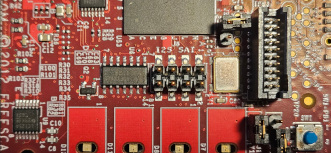
K70 I2S SAI J6 2x4 Header
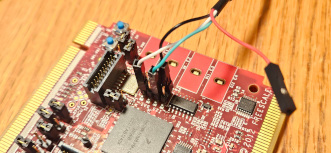
K70 with Adafruit 954 Connection
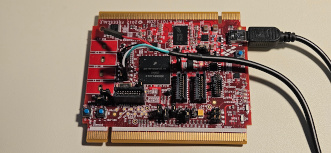
TWR-K70F120M with Power USB & Adafruit 945
- These are images showing the J-Link EDU mini connected via the included 20-to-20 pin cable:
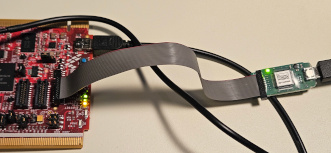
J-Link EDU mini with 20-to-20 Pin Cable
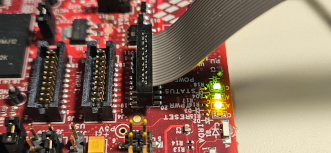
J-Link EDU mini with 20-to-20 Pin Cable at K70

J-Link EDU mini 20-to-20 Pin Cable Side View
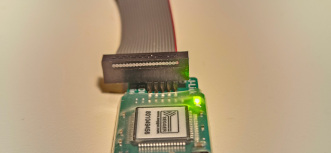
J-Link EDU mini 20-to-20 Pin Cable Edge View
- These are images showing the J-Link EDU mini connected via the 1BitSquared 10-to-20 pin cable:

J-Link EDU mini with 10-to-20 Pin Cable
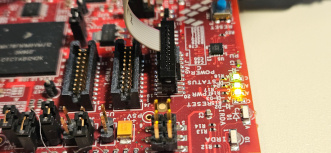
J-Link EDU mini with 10-to-20 Pin Cable at K70

J-Link EDU mini with 10-to-20 Pin Cable at K70
- This is an image showing the TWR-K70F120M with Power USB, J-Link EDU mini with 10-to-20 pin cable & Adafruit 954:
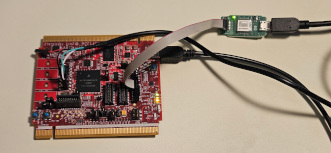
TWR-K70F120M with Power USB, J-Link EDU mini & Adafruit 954
- To install CodeWarrior Development Studio for Microcontrollers 11.1 Special Edition, browse to CodeWarrior for MCUs (Eclipse IDE), Special Edition and follow the directions.
- Follow these directions on how to install CodeWarrior.
- Follow these directions on how to build a new project using CodeWarrior.
- Follow these directions on how to connect the NXP/Freescale K70 Tower System to a computer when not using the Segger J-Link EDU.

K70 Tower without J-Link

K70 Tower without J-Link
- Follow these directions on how to assemble the NXP/Freescale Tower with the primary and secondary elevators and with the TWR-LCD-RGB.
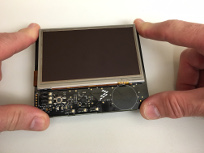
Assembling the TWR-LCD-RGB
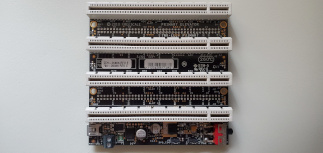
K70 Tower Primary Elevator
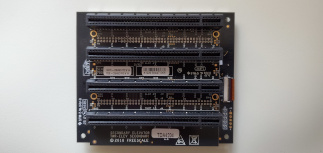
K70 Tower Secondary Elevator

Three Position Slide Switch on Primary Elevator
- Follow these directions on how to connect the NXP/Freescale K70 Tower System to a computer when using the Segger J-Link EDU (*not* the Segger J-Link EDU mini).
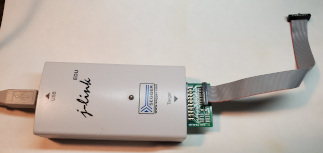
Segger J-Link EDU with Cortex-M Adapater

Close-up of 19-pin Cortex-M Adapter Ribbon Cable
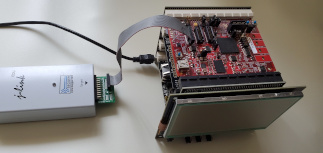
K70 Tower with J-Link, but without Serial
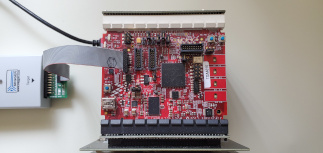
K70 Tower with J-Link, but without Serial
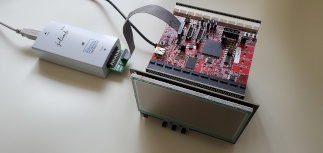
K70 Tower with J-Link, but without Serial
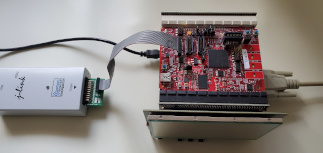
K70 Tower with J-Link & Serial
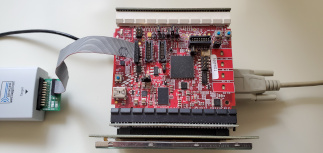
K70 Tower with J-Link & Serial

K70 Tower with J-Link & Serial
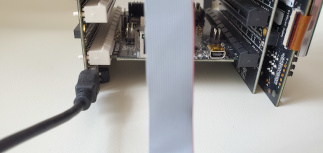
Power Connection to Primary Elevator
- To connect the K70 Tower System to a new Macintosh with a USB-C (also known as USB Type-C) connector (such as on a MacBook Pro), a USB 2.0 USB-C to USB Mini-B cable such as Cable Matters #201004, 3.3 foot cable can be used. The Cable Matters #201004 is available at many resellers including Amazon
- Follow these directions on how to run a project under CodeWarrior. These directions include how to deal with the CodeWarrior pop-up message that says, "Old OSJTAG/OSBDM firmware has been detected. The embedded firmware needs to be in bootloader mode to update. Please unplug the USB cable, insert a jumper on the 2-pin bootloader header (connecting JM60 IRQ to ground), and reconnect the USB cable."
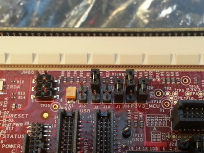
Above View of K70 Tower Header J10
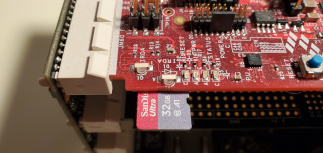
microSD card partially inserted in TWR-K70F120M Tower
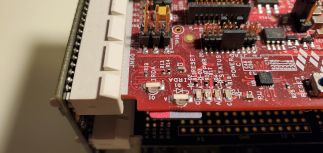
microSD card fully inserted in TWR-K70F120M Tower
- Follow these directions on how to install CodeWarrior 11.1 on an Apple Silicon M-Series Mac.
- No longer functional directions are available on how to install Kinetis Design Studio (KDS) on Windows 10, Mac, or on Linux (including Fedora and Ubuntu) and then run a project in that Integrated Development Environment (IDE) on the K70.
- NXP/Freescale Documents and Software
- The NXP Semiconductors Web Site.
- NXP/Freescale Special Edition CodeWarrior for Microcontrollers 10.6 (Eclipse, Windows hosted, Offline -- Complete download that does not require Internet access during installation) Download
- NXP/Freescale Kinetis K70 Family Fact Sheet.
- NXP/Freescale TWR-K70F120M Tower Module User's Manual.
- NXP/Freescale TWR-K70F120M Quick Start Guide.
- NXP/Freescale TWR-K70F120M Schematics, Rev. B1.
- NXP/Freescale TWR-K70F120M Schematics, Rev. C2.
- NXP/Freescale TWR-SER User Manual.
- NXP/Freescale TWR-SER Schematics, Rev. D.
- NXP/Freescale TWR-PROTO Prototyping Module Quick Start Guide.
- NXP/Freescale Embedded Warrior Library (EWL) C Reference Manual.
- NXP/Freescale K70 Sub-Family Data Sheet for MK70FX512VMJ12 & MK70FN1M0VMJ12, Rev. 7, Feb-2018.
- NXP/Freescale K70 Sub-Family Reference Manual, Rev. 4, Oct-2015 or Alternate link.
- NXP/Freescale Freescale Embedded GUI (D4D), DRM116, Rev. 2, Oct-2010.
- NXP/Freescale Freescale Embedded Graphical User Interface (GUI) Fact Sheet.
- NXP/Freescale Other CodeWarrior Downloads.
- NXP/Freescale Bare Metal Sample Code for Kinetis 120MHz Processors.
- ARM Documents and Software
- ARM Limited Cortex M4 Technical Reference Manual or Alternate link.
- ARM Limited Cortex-M4 Devices Generic User Guide.
- ARM Limited CoreSight ETM-M4 Technical Reference Manual.
- ARM Limited ARMŪv7-M Architecture Reference Manual, Issue E.b, 2014-12-02 or Alternate link 1 or Alternate link 2.
- ARM Limited ARMŪv7-M Architecture Reference Manual, Errata markup, ARM DDI 0403Derrata 2010_Q3 (ID100710).
- ARM Limited Procedure Call Standard for the ArmŪ Architecture, 2022Q1.
- ARM ARM GNU Toolchain.
- ARM GNU Arm Embedded Toolchain Downloads for 32-bit Arm Cortex-A, Arm Cortex-M, and Arm Cortex-R processor families.
- ARM Limited ARM ELF File Format, ARM DUI 00101-A.
- ARM Limited ARM ELF, SWS ESPC 0003 B-02.
- ARM Limited ELF for the ARMŪ Architecture.
- ARM Limited ELF for the ARMŪ 64-bit Architecture (AArch64).
- ARM Limited ARM Synchronization Primitives, Development Article DHT0008A (ID081709).
- Notes from Harald Kipp entitled the ARM GCC Inline Assembler Cookbook.
- SD Documents
- SD Association Part 1 Simplified: Physical Layer Simplified Specification, Version 8.00.
- Refer to the Microsoft Extensible Firmware Initiative FAT32 File System Specification, Version 1.03 for detailed information on the FAT32 file system. There is an important correction to make to this document that concerns the DIR_CrtTimeTenth field in the FAT 32 Byte Directory Entry Structure. The name and description of this field is incorrect. Instead of DIR_CrtTimeTenth, we will use the name DIR_CrtTimeHundth. Here is the correct description of this field (to update the text on page 23):
Hundredths of a second time at file creation time. This field contains a count of hundredths of a second. Because the seconds portion of the DIR_CrtTime field denotes a creation time with a granularity of 2 seconds, this field contains a number of hundredths of a second (0 to 199, inclusively) that denotes a number of seconds from 0 to 1.99, inclusively, that may increment the number of seconds in addition to supplying the number of hundredths of a second.
There is also a typo on page 25 where a field is referred to as DIR_CrtTimeMil (which does not exist, and, in any case, should be DIR_CrtTimeHundth!)
USB to Serial Adapter:
The MXT100 is available at many resellers including Amazon
To connect the USA-19HS to a new Macintosh with a USB-C (also known as USB Type-C) connector (such as on a MacBook Pro), a USB 2.0 USB-C to USB-B cable such as Cable Matters #201002, 3.3 foot cable can be used. The Cable Matters #201002 is available at many resellers including Amazon
Segger J-Link Debug Probes:
- The built-in debug interface utilizes OSJTAG over USB at connector J13. This OSJTAG interface also provides a USB to serial bridge. The driver for OSJTAG requires Microsoft Windows or a Microsoft Windows VM on an x86 processor (i.e., an Apple M-Series processor cannot run this driver). The Segger J-Link EDU and the Segger J-Link EDU mini provide alternative means to connect your computer to the NXP K70 Tower assembly for purposes of downloading programs and debugging programs on the K70. It is possible to use the J-Link devices on x86 and M-Series processors. Both J-Link devices enable faster programming time and additional debugging capabilities. The J-Link EDU devices connect to the TWR-K70F120M's J11 Cortex Debug+ETM Connector (see Section 2.4.2 of the TWR-K70F120M Tower Module User's Manual, Rev. 1.2).
- Drivers for the J-Link EDU devices are available from http://www.segger.com/download_jlink.html. Remember to download and install the appropriate driver before connecting the Segger J-Link device.
- To connect the J-Link EDU to the TWR-K70F120M's J11 Cortex Debug+ETM Connector, a 19-pin Cortex-M Adapter is required.
- The J-Link EDU mini and J-Link EDU also connect to your computer over USB. The Segger J-Link devices allow both CodeWarrior and the Kinetis Design Studio (KDS) to communicate with the K70F120M. J-Link devices also support the Kinetis program trace facility (using the Embedded Trace Macrocell (ETM) of the Kinetis processor) with much more memory for program traces than the built-in K70 ETB (Embedded Trace Buffer). The K70 ETB has 2KB whereas the Segger J-Link has an 8MB external trace buffer. Do not attempt to use the OSJTAG and the J-Link simultaneously.
- Segger J-Link EDU mini
- Segger J-Link EDU Low-cost J-Link for educational purposes
- Segger J-Link 19-pin Cortex-M Adapter is also needed to connect the J-Link EDU to the TWR-K70F120M board
To connect the J-Link EDU to a new Macintosh with a USB-C (also known as USB Type-C) connector (such as on a MacBook Pro), a USB 2.0 USB-C to USB-B cable such as Cable Matters #201002, 3.3 foot cable can be used. The Cable Matters #201002 is available at many resellers including Amazon
If you purchased your own J-Link EDU and 19-pin Cortex-M Adapter, you need to remove the 20-pin JTAG connector cable that came attached to the J-Link EDU and replace it with the 19-pin Cortex-M Adapter. Note that the 19-pin Cortex-M Adapter is polarized so that it can be plugged into the J-Link EDU in only the correct orientation.
Before connecting the J-Link EDU to your computer over USB, download the appropriate J-Link Software and Documentation Pack for your computer's operating system and install the J-Link USB drivers.
To connect the J-Link EDU mini to your TWR-K70F120M board, see the photos above labelled "These are images showing the J-Link EDU mini connected via the included 20-to-20 pin cable" and "These are images showing the J-Link EDU mini connected via the 1BitSquared 10-to-20 pin cable"
1BitSquared JTAG SWD 10pin to 20pin IDC Cable:
- 1BitSquared has a 10-pin to 20-pin ribbon cable with 0.05 inch pin pitch.
- This cable can be used to connect the Segger J-Link EDU mini (which has a 10-pin header) to the TWR-K70F120M J11 JTAG header (which has a 20-pin header).
- The 1BitSquared 10-pin to 20-pin IDC Ribbon Cable for JTAG is a cleaner solution to the connector size mismatch issue.
MicroSDHC Card:
- We will be using the microSDHC card interface on the K70. The microSDHC cards that you use for this class should not be used for any other purpose. More explicitly, since you will be writing code to read and write the microSDHC card at the lowest level, during your code development in this class it is possible for you to make any data on the card inaccessible. Possible microSDHC cards are listed here:
- You will want to be able to read and write your microSDHC cards from your primary development computer as well as from the K70 Tower. Therefore, you'll need to ensure that you have a device that allows a microSDHC card to be connected to your primary computer. A couple of such devices are listed here:
- You will also want to be sure that you have sufficient USB slots in your primary development computer to support all of the USB devices needed to connect to the K70 Tower and also for the microSDHC to USB adapter. Depending on whether you are using the Segger J-Link EDU, this may require four USB slots (#1 to power the K70 Tower, #2 for the Segger J-Link EDU, #3 for the Tripp-Lite Keyspan USA-19HS, and #4 for the microSDHC to USB adapter). We highly recommend that you use a powered USB hub for this purpose. One such device is listed here:
System files for the Kinetis K70F120M/MK70FN1M0 (120 MHz), GCC Toolchain:
System files for the Kinetis K70F120M/MK70FN1M0 (120 MHz), NXP/Freescale Toolchain:
- Declarations of processor specific registers (in C): derivative.h
- Declarations of processor specific registers (in C): MK70F12.h
- Declarations of memory layout (in linker) for RAM targets: MK70FN1M0_ram.lcf
- Declarations of memory layout (in linker) for Flash targets: MK70FN1M0_flash.lcf
- Metrowerks ARM Runtime Support Library/Entry point for ARM programs (functions in C): startup.c
- Kinetis ARM specific initial startup code (in C): kinetis_sysinit.c
- Kinetis ARM specific initial header file (in C): kinetis_sysinit.h
- Kinetis TWR-K70F120M tower CPU specific header file (in C): twr-k70f120m.h
Sample programs for the Kinetis K70F120M/MK70FN1M0 (120 MHz):
CSCI E-92 Application Notes for using the Kinetis K70F120M/MK70FN1M0 (120 MHz):
Electronics stores in the Greater Boston Area:
Electronics distributors on the Web:
- Digi-Key Corporation. Located at 701 Brooks Avenue South, Thief River Falls, MN 56701-0677; Telephone: 1.800.344.4539, Fax: 1.218.681.3380.
- Mouser Electronics, Inc.. Located at 1000 North Main Street, Mansfield, TX 76063-1511; Telephone: 1.800.346.6873, Fax: 1.817.804.3899.
- Allied Electronics. The corporate headquarters are located at 7410 Pebble Drive, Fort Worth, TX 76118; Telephone: 1.800.433.5700, Fax: 1.817.595.6444.
Hardware (as in nuts and bolts, etc.) distibutors on the Web:
- McMaster-Carr Supply Company. Located at P. O. Box 440, New Brunswick, NJ 08903-0440; Telephone: 1.732.329.3200, Fax: 1.732.329.3772.
- W. W. Grainger, Inc.. Located at 100 Grainger Parkway, Lake Forest, IL 60045-5201; Telephone: 1.847.535.1000.
- Small Parts Inc. Was acquired by Amazon and operated as AmazonSupply. Now is part of Amazon Business.
Static dissipative devices used in the lab:
The ring terminal at the end of the common point ground wire should be attached to the nearest electrical outlet faceplace using the screw between the outlets of a duplex outlet. Note that the alligator clips connected to the wires on both the anti-static mat and the wrist strap are removeable. The alligator clips are actually adapters from banana plugs to alligator clips similar to  . After the alligator clip adapter is pulled off, the banana plug can be plugged into one of the two banana jacks on the common point ground. Both the anti-static mat's banana plug and the wrist strap's banana plug should be plugged into the common point ground.
. After the alligator clip adapter is pulled off, the banana plug can be plugged into one of the two banana jacks on the common point ground. Both the anti-static mat's banana plug and the wrist strap's banana plug should be plugged into the common point ground.
Software and Course Documents On-Line:
Slides used in class
The Course Questionnaire and Problem Sets
- The course questionnaire is
available on-line. Please submit your completed questionnaire using
"git" with the tag "problem-set-0" as soon as possible after our first
class meeting.
- Problem Set 0 (the course questionnaire, fix-this-program.c & word-count.c)
- Problem Set 1 (textbook problems; simple shell including conversion of microseconds since the Unix epoch to printable form)
- Problem Set 2 (textbook problems; memory management: malloc & free, shell enhancements, K70 LED flashing program)
- Problem Set 3 (port your myMalloc, myFree, and myFreeErrorCode implementations to the K70; use UART serial input & output for all shell interactions; implement device independent I/O for LEDs, pushbuttons, and FAT32 file system on our microSDHC; shell enhancements)
- Problem Set 4 (K70 enhancements: faster clock, off-chip SDRAM, supervisor calls, serial I/O added to device independent I/O, A-to-D input, and touch sensors, unprivileged mode, shell enhancements)
- Term Project Proposal
- Problem Set 5 (FlexTimer for time and date, interrupt-driven serial I/O, user timer, shell enhancements)
- Problem Set 6 (SysTick for multiprocessing, processes)
Online Software: GNU, Cygwin, etc.
Harvard University Information Technology
- There are computers available for Extension student use at 53a Church Street and in the Science Center, Room B-14. The Science Center computer labs are open 24 hours a day. Apple, PC, and Linux workstations are available for student use.
- Software is available for free download from Harvard Information Technology
- Harvard University Information Technology:
Operating System Reference Material
Online Papers Used in Class
- Here is an interesting discussion of the Mars Rover Pathfinder mission involving priority inversion.
- Here's the discussion of the crash of the Ariane 5 rocket in HTML format and in text format.
- For papers discussing the Internet Worm of November 1988, see note by Gene Spafford & Robert Gasch, General Accounting Office report, University of Lowell report, How to patch the holes, the court appeal, request for comments 1135, MIT-IEEE, MIT, seely, spaf CCR, spaf ESEC.
- Description on blog.CryptographyEngineering.com by Matthew Green of the OpenSSL Heartbleed bug.
- Description of Diffie-Hellman key exchange vulnerability by Alex Halderman and Nadia Heninger.
- Description of Ingenious Chip-and-Pin Card Hack by Andy Greenberg of WIRED.
C* Information
Section Home Page
 . Questions whose answers would be relevant to the whole class should be posed via Ed Discussion. For some appropriate issues (grading questions, personal issues, etc.), e-mail should be sent to the professor and also to both TAs.
. Questions whose answers would be relevant to the whole class should be posed via Ed Discussion. For some appropriate issues (grading questions, personal issues, etc.), e-mail should be sent to the professor and also to both TAs.
 ,
,
 ; +1 571.265.2932 (Weekdays: 10:00 AM - 10:00 PM ET). If there's no answer, please leave a message with your name and a call-back number. Questions whose answers would be relevant to the whole class should be posed via
; +1 571.265.2932 (Weekdays: 10:00 AM - 10:00 PM ET). If there's no answer, please leave a message with your name and a call-back number. Questions whose answers would be relevant to the whole class should be posed via  ,
,
 ; +1.617.401.8836 (11:00 AM - 9:00 PM ET). If there's no answer, please leave a message with your name and a call-back number. Questions whose answers would be relevant to the whole class should be posed via
; +1.617.401.8836 (11:00 AM - 9:00 PM ET). If there's no answer, please leave a message with your name and a call-back number. Questions whose answers would be relevant to the whole class should be posed via 



























 . After the alligator clip adapter is pulled off, the banana plug can be plugged into one of the two banana jacks on the common point ground. Both the anti-static mat's banana plug and the wrist strap's banana plug should be plugged into the common point ground.
. After the alligator clip adapter is pulled off, the banana plug can be plugged into one of the two banana jacks on the common point ground. Both the anti-static mat's banana plug and the wrist strap's banana plug should be plugged into the common point ground.